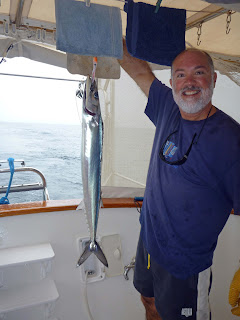Our journey up the west coast of Africa has
so far been a downwind pleasure and a delight. After the trials and
tribulations of dodging depressions and fronts while crossing powerful currents
on the route from Madagascar to South Africa, the west coast was the reward. We
experienced no squalls or lightning. North of Cape Town, the winds became
lighter and more reliable, the skies were mostly clear and blue, and the
current light and favorable if a little chilly; seals, dolphins, whales, cormorants
and penguins abounded. We saw several Southern Royal Albatross which we had not
seen before. These birds are huge and
graceful. We finally had some luck
fishing and landed a rainbow runner and a small Bluefin tuna that made tasty
sushi for Emily and I.
The three night voyage north was complicated
by one of the local nautical quirks, the ice cold north flowing Antarctic
Benguela current causes chilly nights, condensation in previously dry areas
near the water and fog patches. It was nice for once to be a motorboat since we
closed up the cabin completely and enjoyed 70 degree temps while our sailing
friends donned hats and mittens. However,
we arrived in Lüderitz, anchored safely and quickly completed the formalities
with Immigration, Customs and Port Control.
Namibia is largely a desert or semi desert
particularly in the coastal regions. Lüderitz was an intriguing art deco style
town originating from Colonial days when it was claimed by Germany. Post World
War I, South Africa took over with a League of Nations mandate, which they
effectively turned into ownership until 1990 when Independence was declared. On
initial impressions, there seems to be no particularly good reason for building
this town in the middle of sand dunes. However, inspection of the many peculiar
looking fishing boats in the harbor gives a clue. They are indeed fishing boats
- for diamonds. Instead of carrying nets, they have long hoses hanging off the
back, vacuum cleaners for the diamonds washed down the Orange River further to
the south. There were also some fishing boats, but they appeared to be in a
minority.
Tourism for the desert terrain is the other
major industry, in which we were here to participate. We strolled around the pretty town and grocery
shopping was an easy walk. There were
pink flamingos, pelicans, seals and huge jellyfish. The jellyfish were not a problem since no one
had a desire to go in the ice cold water.
The town soon developed, becoming a bustling little center and providing shelter for workers from the harsh environment of the Namib Desert. Large, elegant houses were built and it soon resembled a German town, complete with an impressive array of amenities including; a hospital, ballroom, power station, school, 4-lane bowling alley, theatre and sports hall, casino, ice factory and the first x-ray station in the southern hemisphere. Fresh meat could be purchased at the butchers; there was a bakery, furniture factory, a public playground and even a swimming pool! At the time, there was also a railway line to Luderitz.
The development of Kolmanskop reached its pinnacle in the 1920's, but the town declined after World War 1, when diamond prices crashed. At this time approximately 300 German adults, 40 children and 800 Owambo contract workers lived in the town. In spite of, or probably because of, the isolation and bleakness of the surrounding desert, Kolmanskop developed into a lively little haven of German culture, offering entertainment and recreation to suit the requirements of the affluent colonialists.
Unfortunately for Kolmanskop and its inhabitants, richer diamond deposits were discovered further south, and operations were moved to Oranjemund. Within a span of 40 years Kolmanskop lived, flourished and died.
We enjoyed a nice tour with an English guide and had some time to explore the buildings on our own. It was amazing to see an entire town where the people just left and let the desert sand drift in.
After only 4 days, we decided to tag along with Moonbeam and Muneera and we all headed north for the two night passage to Walvis Bay. Again, we had a calm trip and only the fog detracted from the nice passage. We passed huge pods of fur seals miles out at sea. They would pop up and look at us and then race after us as we passed. We landed a King Mackerel along the way and it was nice to be catching fish again.
We were looking forward to Walvis Bay because we were investigating another inland trip to go on a final safari and do some quad bike tours in the desert. Stay with us Dear reader and see if we get eaten by a lion or lost in the Namib Desert!
Tom
















1 comment:
Hi, this is Fábio Lima. The guy that met you this afternoon here in Recife. I would like to congratulate you for your great adventure around the world. Your story is inspiring. I hope to see it in our newspapers. Today I wrote to them. I'll follow you here at blogspot. Bon voyage!
Ps: sorry for my inglish.
fabiohistoriaunicap@hotmail.com
Post a Comment